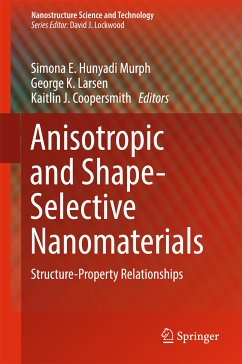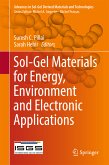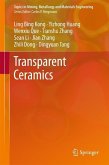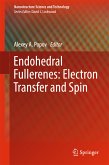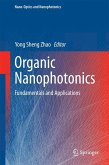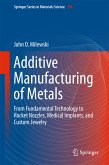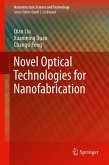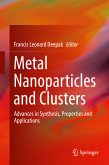Anisotropic and Shape-Selective Nanomaterials (eBook, PDF)
Structure-Property Relationships
Redaktion: Hunyadi Murph, Simona E.; Coopersmith, Kaitlin J.; Larsen, George K.
113,95 €
113,95 €
inkl. MwSt.
Sofort per Download lieferbar

57 °P sammeln
113,95 €
Als Download kaufen

113,95 €
inkl. MwSt.
Sofort per Download lieferbar

57 °P sammeln
Jetzt verschenken
Alle Infos zum eBook verschenken
113,95 €
inkl. MwSt.
Sofort per Download lieferbar
Alle Infos zum eBook verschenken

57 °P sammeln
Anisotropic and Shape-Selective Nanomaterials (eBook, PDF)
Structure-Property Relationships
Redaktion: Hunyadi Murph, Simona E.; Coopersmith, Kaitlin J.; Larsen, George K.
- Format: PDF
- Merkliste
- Auf die Merkliste
- Bewerten Bewerten
- Teilen
- Produkt teilen
- Produkterinnerung
- Produkterinnerung

Bitte loggen Sie sich zunächst in Ihr Kundenkonto ein oder registrieren Sie sich bei
bücher.de, um das eBook-Abo tolino select nutzen zu können.
Hier können Sie sich einloggen
Hier können Sie sich einloggen
Sie sind bereits eingeloggt. Klicken Sie auf 2. tolino select Abo, um fortzufahren.

Bitte loggen Sie sich zunächst in Ihr Kundenkonto ein oder registrieren Sie sich bei bücher.de, um das eBook-Abo tolino select nutzen zu können.
This book reviews recent advances in the synthesis, characterization, and physico-chemical properties of anisotropic nanomaterials. It highlights various emerging applications of nanomaterials, including sensing and imaging, (bio)medical applications, environmental protection, plasmonics, catalysis, and energy. It provides an excellent and comprehensive overview of the effect that morphology and nanometric dimension has on the physico-chemical properties of various materials and how this leads to novel applications.
- Geräte: PC
- ohne Kopierschutz
- eBook Hilfe
- Größe: 17.81MB
Andere Kunden interessierten sich auch für
![Sol-Gel Materials for Energy, Environment and Electronic Applications (eBook, PDF) Sol-Gel Materials for Energy, Environment and Electronic Applications (eBook, PDF)]() Sol-Gel Materials for Energy, Environment and Electronic Applications (eBook, PDF)121,95 €
Sol-Gel Materials for Energy, Environment and Electronic Applications (eBook, PDF)121,95 €![Transparent Ceramics (eBook, PDF) Transparent Ceramics (eBook, PDF)]() Ling Bing KongTransparent Ceramics (eBook, PDF)113,95 €
Ling Bing KongTransparent Ceramics (eBook, PDF)113,95 €![Endohedral Fullerenes: Electron Transfer and Spin (eBook, PDF) Endohedral Fullerenes: Electron Transfer and Spin (eBook, PDF)]() Endohedral Fullerenes: Electron Transfer and Spin (eBook, PDF)113,95 €
Endohedral Fullerenes: Electron Transfer and Spin (eBook, PDF)113,95 €![Organic Nanophotonics (eBook, PDF) Organic Nanophotonics (eBook, PDF)]() Organic Nanophotonics (eBook, PDF)40,95 €
Organic Nanophotonics (eBook, PDF)40,95 €![Additive Manufacturing of Metals (eBook, PDF) Additive Manufacturing of Metals (eBook, PDF)]() John O. MilewskiAdditive Manufacturing of Metals (eBook, PDF)48,95 €
John O. MilewskiAdditive Manufacturing of Metals (eBook, PDF)48,95 €![Novel Optical Technologies for Nanofabrication (eBook, PDF) Novel Optical Technologies for Nanofabrication (eBook, PDF)]() Qian LiuNovel Optical Technologies for Nanofabrication (eBook, PDF)73,95 €
Qian LiuNovel Optical Technologies for Nanofabrication (eBook, PDF)73,95 €![Metal Nanoparticles and Clusters (eBook, PDF) Metal Nanoparticles and Clusters (eBook, PDF)]() Metal Nanoparticles and Clusters (eBook, PDF)73,95 €
Metal Nanoparticles and Clusters (eBook, PDF)73,95 €-
-
-
This book reviews recent advances in the synthesis, characterization, and physico-chemical properties of anisotropic nanomaterials. It highlights various emerging applications of nanomaterials, including sensing and imaging, (bio)medical applications, environmental protection, plasmonics, catalysis, and energy. It provides an excellent and comprehensive overview of the effect that morphology and nanometric dimension has on the physico-chemical properties of various materials and how this leads to novel applications.
Dieser Download kann aus rechtlichen Gründen nur mit Rechnungsadresse in A, B, BG, CY, CZ, D, DK, EW, E, FIN, F, GR, HR, H, IRL, I, LT, L, LR, M, NL, PL, P, R, S, SLO, SK ausgeliefert werden.
Produktdetails
- Produktdetails
- Verlag: Springer International Publishing
- Seitenzahl: 470
- Erscheinungstermin: 14. Juli 2017
- Englisch
- ISBN-13: 9783319596624
- Artikelnr.: 53036014
- Verlag: Springer International Publishing
- Seitenzahl: 470
- Erscheinungstermin: 14. Juli 2017
- Englisch
- ISBN-13: 9783319596624
- Artikelnr.: 53036014
- Herstellerkennzeichnung Die Herstellerinformationen sind derzeit nicht verfügbar.
¿Prof. Dr. Simona Hunyadi Murph is an internationally recognized expert in the fields of nanoscience and nanotechnology. Dr. Murph is a Principal Scientist in the National and Homeland Security Directorate at Savannah River National Laboratory (SRNL) and an Adjunct Professor at the Department of Physics and Astronomy, the University of Georgia (UGA), USA. She is the founder and manager of the SRNL's Group for Innovation and Advancements in NanoTechnology Sciences (GIANTS) program, which is intended to advance young scholars' knowledge and skills in the many fields of nanoscience. Her group's research focuses on the design and control of fabrication for colloidal materials with functional properties for sensing and imaging, catalysis, bio-medical and environmental applications, plasmonics, energy conversion and storage. The remarkable advances made by Dr. Murph and her team in the field of nanotechnology have led to numerous publications, awards, grants, invention disclosures, and patents. She holds a PhD in Chemistry/Nanotechnology from the University of South Carolina, USA, an Education Specialist/Educational Leadership (EdS) degree from Augusta University, USA, and both a Master of Science (MS) in Chemistry and Bachelor of Science (BS) in Chemistry/Physics with a minor in Education from Babes-Bolyai University in Romania. Dr. George K. Larsen is a Senior Scientist at the Savannah River National Laboratory (SRNL). After receiving a Bachelor of Arts (BA) and Bachelor of Science (BS) in Philosophy and Physics from Piedmont College, USA, Dr. Larsen attended the University of Georgia, earning a PhD in Physics. Dr. Larsen's research concentrates on the properties and applications of nanostructures, covering a range of topics from clean energy to the electrical properties of tilted nanorod arrays. At the SRNL, Dr. Larsen's work focuses on the exploitation of nanostructures for remote heat generation, photocatalysis, hydrogenproduction, and radiation safety, among others. Dr. Kaitlin J. Coopersmith is a Senior Scientist at the Savannah River National Laboratory in Aiken, SC, USA. She received her PhD in Chemistry from Syracuse University, USA and her Bachelor of Science (BS) in Chemistry from the State University of New York at Potsdam. Her research interests include the synthesis and functionalization of metal and semiconductor nanoparticles for sensing, drug delivery, energy transfer, gas adsorption, and alternative heating mechanisms.
Part I: Introduction and Fundamentals.- An Introduction to Nanotechnology.- Nanoscale Materials: Fundamentals and Emergent Properties.- Synthetic Strategies for Anisotropic and Shape-Selective Nanomaterials.- Characterization of Anisotropic and Shape-Selective Nanomaterials: Methods and Challenges.- Part 2: Effect of the morphology and the nanometric dimension of materials on their physico- chemical properties.- Anisotropic Metallic and Metallic Oxide Nanostructures - Correlation between their shape and properties.- Putting Nanoparticles to Work: Self-propelled Inorganic Micro- and Nanomotors.- Prospects for rational control of nanocrystal shape through successive ionic layer adsorption and reaction (SILAR) and related approaches.- Plasmon Drag Effect. Theory and Experiment.- Dimensional Variations in Nanohybrids: Property Alterations, Applications, and Considerations for Toxicological Implications.- Assemblies and Superstructures of Inorganic Colloidal Nanocrystals.- Nanostructured Catalysts for the Electrochemical Reduction of CO2.- Strategies for the Synthesis of Anisotropic Catalytic Nanoparticles.- Biomedical Applications of Anisotropic Gold Nanoparticles.- Application of Gold Nanorods in Cardiovascular Science.- Architectured Nanomembranes.- Summary and Final Thoughts.
Part I: Introduction and Fundamentals.- An Introduction to Nanotechnology.- Nanoscale Materials: Fundamentals and Emergent Properties.- Synthetic Strategies for Anisotropic and Shape-Selective Nanomaterials.- Characterization of Anisotropic and Shape-Selective Nanomaterials: Methods and Challenges.- Part 2: Effect of the morphology and the nanometric dimension of materials on their physico- chemical properties.- Anisotropic Metallic and Metallic Oxide Nanostructures - Correlation between their shape and properties.- Putting Nanoparticles to Work: Self-propelled Inorganic Micro- and Nanomotors.- Prospects for rational control of nanocrystal shape through successive ionic layer adsorption and reaction (SILAR) and related approaches.- Plasmon Drag Effect. Theory and Experiment.- Dimensional Variations in Nanohybrids: Property Alterations, Applications, and Considerations for Toxicological Implications.- Assemblies and Superstructures of Inorganic Colloidal Nanocrystals.- Nanostructured Catalysts for the Electrochemical Reduction of CO2.- Strategies for the Synthesis of Anisotropic Catalytic Nanoparticles.- Biomedical Applications of Anisotropic Gold Nanoparticles.- Application of Gold Nanorods in Cardiovascular Science.- Architectured Nanomembranes.- Summary and Final Thoughts.
